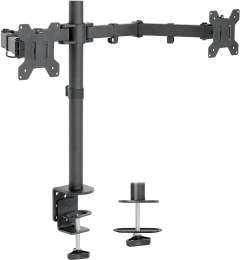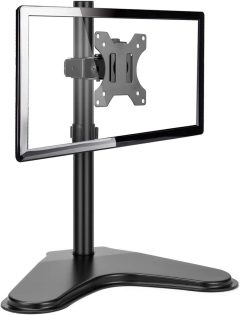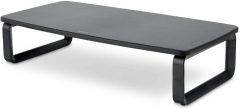BestReviews is reader-supported and may earn an affiliate commission. Details

A beautiful and stable monitor arm from a pioneering company in the field.
Sleek polished aluminum design. Supports monitors up to 34 inches weighing up to 25 pounds. Raises screen up 17 inches. Allows 75 degrees of tilt and full 360-degree rotation. Offers both clamp and grommet mounts for desks from 0.4 to 2.4 inches thick.
Expensive. Cable management consists of zip ties.

A dedicated monitor stand for a true dual-monitor setup.
Retains full functionality and articulation due to the smart support-arm design and construction. Ability to move each monitor independently allows for a variety of positions and setups above the desk. Narrow profile maximizes desk space.
The support fastener can leave marks on desk surfaces when too much pressure is applied.

A strong and stable freestanding monitor mount with wide angles of motion.
Wide V-shaped base measures 15.3 x 11.4 inches for stability. Holds monitors up to 32 inches weighing up to 17.6 pounds. Offers swivel, tilt, and full 360-degree rotation with height up to 18 inches. Includes cable slot.
Adjusting the height requires hex wrenches and takes time.

For a basic yet height-adjustable monitor stand with extra space, consider this riser.
Wide 24-inch area to support a variety of monitor pedestals and feet. Supports up to 40 pounds. Large 20 x 11-inch footprint for under-stand storage. The minimum 2.25-inch height can be raised with removable leg modules.
Plastic construction compared to metal or wood competitors.

This metal monitor stand features a built-in USB hub and wireless charging pad.
Aluminum construction. Raises monitor more than 3 inches. Includes integrated USB 3.0 hub with 4 ports and connection to a computer, plus a 15W Qi charging pad. Supports up to 66 pounds and displays of 27 inches.
Wireless mat may not be compatible with iPhones featuring MagSafe.

We recommend these products based on an intensive research process that's designed to cut through the noise and find the top products in this space. Guided by experts, we spend hours looking into the factors that matter, to bring you these selections.

Every person who works for any length of time at a computer needs to consider their comfort. Laptops and tablets force users to hunch forward for extended periods, causing strain in the eyes, neck, shoulders, and even the arms and spine. Popular all-in-one computers have displays with no height adjustment and limited tilt. A separate monitor with a good monitor stand allows you to customize your setup for your health and comfort, and also adds space by getting your display or all-in-one computer off your desk.
There are several things to consider when choosing a monitor stand. The stand that works best for you depends on your budget, your needs, and the way you want your workspace to look.

Monitor arms attach to your monitor by means of screws or other mounts. For stability, they can clamp or screw onto your desk or mount on a wall. They’re articulated for excellent adjustability but aren’t the most attractive.
Monitor risers or pedestals sit on your desk and offer a flat shelf for your monitor. These can sometimes be adjustable and usually offer extra storage space or organization or boast stylish designs.
Freestanding mounts combine elements of arms and risers. Like a riser, they sit on your desktop and have few or any articulations, but like an arm they mount to the back of your monitor and allow you to change height and tilt, and sometimes angle and rotation.
Most people use only one display. If you have more than one display, look into getting a dual monitor stand (or even a triple one) for maximum comfort and flexibility in your setup.
A monitor stand’s description and details should tell you its maximum bearing weight or load capacity. You don’t want a flimsy stand that can sink, sag, or collapse under the weight of your monitor.
Monitor stands can sit on your desk, attach to it, or attach to a wall. Look for a base or mount that’s stable and won’t wobble or shift with use. Make sure the base is capable of supporting your monitor in various positions without becoming unbalanced. See how much space it may need — especially clamps that attach to the edge of a desk or table. Check if the clamps or bases will damage your desk.
A good monitor stand should be made of materials that can bear the weight of a display and hold up well over time. An articulated monitor arm should have joints that move smoothly and quietly and firmly hold their position. Steel, aluminum, and hardwood are good materials for monitor stands. Glass stands can be beautiful but fragile.
Having a neat, organized, and appealing workspace isn’t just an indulgence. Feeling organized and pleased with your work area can lead to lower stress, higher confidence, and higher efficiency, and most importantly help you feel good while you work.
Measure your desk’s thickness to ensure it fits in a clamp or grommet monitor stand base.
The most important feature of any monitor stand is its elevation. A monitor stand should place the top edge of your display’s screen at or just below eye level. Monitor risers and similar platforms often have a fixed elevation, but some are adjustable. Monitor arms and freestanding mounts almost always allow adjustable elevation.
Another desirable feature in a monitor stand is adjustable tilt, swivel, and rotation. A monitor arm or freestanding mount should allow you to tilt your monitor back and forth as well as elevate it. It’s also helpful to be able to swivel your monitor left or right. Some arms and mounts allow you to rotate your monitor, which can be useful for switching between landscape and portrait orientations. Monitor arms in particular offer extendability and reach, allowing you to change the distance of the screen from you, or show another person your work without any effort.
A majority of flat-panel displays available bear a VESA mounting pattern on the back. This is a pattern of threaded screw holes that are standardized across the industry to fit compatible VESA mounts. VESA mount sizes are expressed in millimeters. Popular sizes for monitors and displays are 75 x 75 millimeters and 100 x 100 millimeters.
Some monitors lack a VESA mounting pattern and are only intended to be used with the stand, base, or feet that came with them. These monitors can still be used with a monitor riser.
Monitor arms often attach to your desk with clamps or bolts. Clamps are intended to attach to the edge of your desk, while bolts are designed to go through your desk and attach with a grommet. Bolting is a semi-permanent way to attach a monitor stand, especially if you have to drill a hole through your desk, but it’s extremely stable, especially for multiple-monitor arms.
A good monitor stand frees up desk space. Instead of adding clutter or reducing usable space with a large footprint, it should create more space beneath your monitor. Monitor risers often open up almost their entire footprint, allowing you to store your keyboard, mouse, tablet, hard drives, hubs, and more beneath your monitor. Some monitor stands offer built-in desk organization, such as drawers, pen cups, and mail holders.
After getting a monitor stand and getting your display off your desk, it can be frustrating to still have power and interface cables dangling everywhere. Monitor stands, especially arms and freestanding mounts, should offer some kind of cable management to keep cables neat and out of the way. This could be Velcro loops, built-in guides, or a flexible duct. Good cable management keeps cables out of the way without sacrificing adjustability or damaging the cords.

VESA adapters allow VESA-compatible mounts, like monitor arms and freestanding mounts, to hold monitors and displays that lack VESA hole patterns.
If your monitor arm or riser doesn’t come with its own cable management system, a good set of cable straps can be beneficial. You can also consider a cable management box, especially if your stand has cleared some desk space.
As one of the standards for connecting TVs and monitors to computers and video sources, you can always use another HDMI cable, especially one with a longer length to accommodate your new monitor stand.
You can find solid and useful monitor stands below $50, including monitor arms, monitor risers, and freestanding mounts. Some very inexpensive monitor stands sacrifice sturdiness and durability for cost, however, and may sag or fail.
Mid-level monitor stands run from $50 to $200. There’s a good selection of both value-focused brands and respected names in this range. You’re more likely to find solid, dependable engineering, durable materials, and thoughtful touches in this price range.
Expensive monitor stands cost above $200. These stands include monitor arms from top office design and ergonomics brands, and monitor risers carved or shaped from real hardwood or metal into elegant pieces of functional decor.
Some inexpensive desks are made of pressed wood or fiberboard, which may not be strong enough to hold a clamp or grommet-bolted monitor arm. It’s also best to avoid using clamped monitor stands on glass desks.

A. Monitor arms are available for mounting on the wall, removing the monitor from your desk altogether. Wall mounting is very stable and can bear a lot of weight. However, it means drilling into the wall, finding a wall stud, and not being able to change your work area’s location easily.
A. If a monitor or display has a VESA mounting pattern on the back, it can be connected to any VESA-compatible monitor arm or freestanding mount that has a matching pattern and can bear its weight. A monitor riser can accommodate any monitor or all-in-one computer that can fit onto its surface and isn’t too heavy. For displays without VESA holes, try a VESA adapter.
A. The further a monitor arm is extended from its base, the more likely it will shake. If your monitor arm is causing your display to visibly shake just by typing on your keyboard, you can try wedging material to stabilize it or adding a counterweight. Even then, it may be better to look for a more stable arm.
A. Any VESA-compatible TV mount should be able to attach to a monitor or display with a matching VESA pattern. However, TVs tend to be larger and heavier than computer monitors, so some mounts have patterns like 200 x 200 millimeters or 300 x 300 millimeters, which your monitor may lack.
Get emails you’ll love.
Learn about the products you’re wondering if you should buy and get advice on using your latest purchases.
